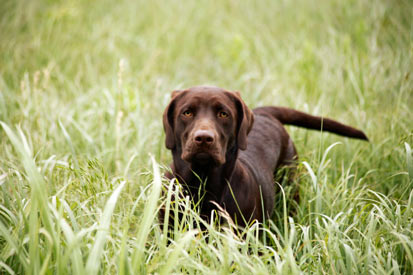Foxtails: A Summertime Hazard for Dogs

Foxtails are more than a nuisance for dogs in the summertime. Their barbs can hook into a dog's body and burrow their way deeply into her tissue, causing various problems.
What Are Foxtails?
There are numerous types of meadow grass that are known as foxtails. These plants sport seed heads, also known as grass awns, which are barbed. The barbs are designed to burrow into the ground once they blow off of the plant in late spring or early summer. Some of these plants are native to the US, but some of them are invasive species. They are present largely in the western half of the US, but they have recently spread to the Midwest and the eastern coast.
Why Are Foxtails Dangerous for Dogs?
A dog that is out running, sniffing, and brushing against tall grasses can come into contact with grass awns, which quickly and easily burrow into almost any part of her body including her nose, ears, eyes, mouth, vulva (penis in males), or anywhere on the skin. Once they have burrowed in, they can continue to migrate further and further into the tissues.
Dogs' bodies can't break down and remove foxtails. Once they find a way in, grass awns can only move forward because of the direction of their barbs. They may be carrying bacteria on them. They damage tissue and cause infection as they dig forward.
Foxtails can also burrow deeply into dogs' bodies. They have been found in the lungs, intestines, spines, ear drums, and even brains of affected dogs. They can easily cause death if they aren't found and treated.
What Are the Signs of Foxtails in Dogs?
The signs that a dog has a burrowed foxtail are incredibly varied and depend on the body location that was invaded. Dogs with foxtails in their feet may limp. Sneezing and rubbing at the face is a common sign of foxtails in the nose. A swollen, red, squinting eye may indicate that a grass awn has found its way into that delicate area.
Once a foxtail is inside your dog's body, it can be extremely difficult to find. They are not visible on x-rays, and they can leave infection and abscesses behind their actual location. Sometimes exploratory surgery is required to hunt down the offending grass awn, and dogs have been known to require multiple surgeries before they are found.
How Can You Protect Your Dog from Foxtails?
Avoiding exposure to foxtails or areas where they are known to be is the ideal protection against your dog picking one up. However, this isn't always a practical solution. If your dog is running in areas with foxtails, be sure that you check her over a few times a day. Use a fine comb to go through her fur everywhere. Part the hair and visually inspect her skin. Check the webbing of her toes and between her paw pads, her mouth, nose, and ears, as well as her vulva and underbelly. Your best bet is to find and remove any grass awns before they burrow in and become undetectable.
If you live in an area where there are a lot of foxtails, ask your groomer to keep any fur between your dog's toes and pads, around her vulva, and at the ear openings trimmed close. This will help you to be able to see these critical areas much more easily when you are doing your visual inspections.
Watch for any signs that your dog may have picked up a foxtail, such as:
- Sneezing
- Coughing
- Squinting
- Limping or licking at the paw
- Firm, painful swellings
- Head-shaking
- Scratching at the ears
- Persistent licking at the genitals
If you see any of these signs, take your dog to the veterinarian immediately, and mention that she has been in an area known to have foxtails.
Here is a link to some pictures of common foxtail plants: www.cpp.edu/~jcclark/dogs/foxtails.html
You May Also Like These Articles:
Dog Weight Loss: Tips For Helping Your Dog Lose Weight
Obesity in Dogs: Overview of Causes and Dangers
Earth Day: Ways to Observe Earth Day with Your Dog
Springtime Hazards for Dogs - Slideshow
The Yellow Dog Project: What Does the Yellow Ribbon Mean?
Dogs Make the Best Matchmakers
How to Stop Your Dog from Jumping on People
Disclaimer: This website is not intended to replace professional consultation, diagnosis, or treatment by a licensed veterinarian. If you require any veterinary related advice, contact your veterinarian promptly. Information at DogHealth.com is exclusively of a general reference nature. Do not disregard veterinary advice or delay treatment as a result of accessing information at this site. Just Answer is an external service not affiliated with DogHealth.com.


